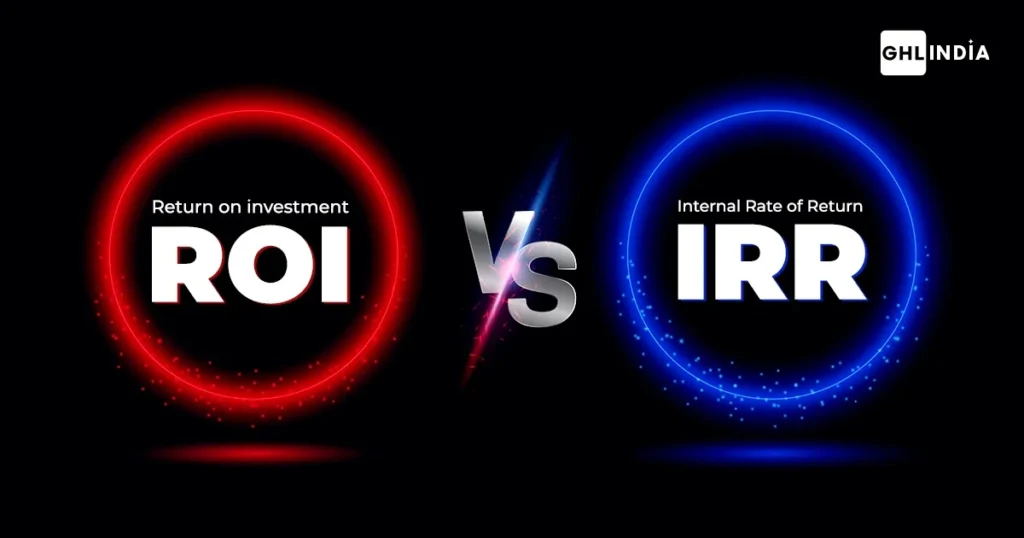
Ever dream of being wealthy? Many of us do, longing to earn more and double our money. We often wonder how to become rich and when it will happen. But here’s a reminder: it’s not just about how much money we make; it’s about how we use it.
Have you heard this concept before? It’s a valuable insight shared by Robert Kiyosaki.
“It’s not how much money you make, but how much money you keep, how hard it works for you, and how many generations you keep it for.” – Robert Kiyosaki.
He emphasizes the importance of using our money wisely and investing it strategically, particularly in assets that can grow over time.
Once we’ve made these strategic investments, how do we figure out our returns? This is where ROI (Return on Investment) and IRR (Internal Rate of Return) come into play. These methods help us analyze our investment returns effectively.
So, why wait? Let’s explore the differences between ROI and IRR to determine which one suits you best!

Comparing ROI and IRR: Let’s Understand Investment Returns
ROI which is popularly used to calculate the return of investment in an easy way. Let’s say you put some money into a stock or a business venture. After a while, you want to know how much you’ve gained or lost on that investment. ROI gives you that answer by calculating the percentage increase or decrease in your initial investment over time. It’s like putting a magnifying glass on your money to see how much it’s grown or shrunk.
Here’s the formula for calculating the ROI,
ROI = (current investment worth) – (original investment worth)
——————————————————————————
(original investment worth)
To calculate the return on investment (ROI) for an investment of $2000, you need to know how much your investment is worth now compared to what you originally invested. For example, if your investment is now worth $2500, here’s how you calculate the ROI:
Subtract your original investment from the current value to find the profit: $2500 – $2000 = $500
Divide the profit by the original investment: $500 / $2000 = 0.25.
Multiply the result by 100 to get the ROI percentage: 0.25 * 100 = 25%.
This is how ROI helps us determine our investment returns.
Curious to know what IRR contributes?
In simple terms, Internal Rate of Return (IRR) is a measure used to evaluate the profitability of an investment. It considers the time value of money , meaning it takes into account the period over which investments are made. This helps in comparing different investment options to see which one has the potential to grow your money the fastest.
Unlike Return on Investment (ROI), which is straightforward to calculate, IRR is a bit more complex and usually requires a calculator or spreadsheet. It is expressed as an annualized rate of return, showing how much your investment grows on average each year .
For example, if you invest $10,000 and after one year it’s worth $11,000, your IRR for that year is 10%, just like your ROI. However, the difference between IRR and ROI becomes more apparent over time. While ROI considers the total return on the initial investment, IRR focuses on the performance of the money that is still actively invested and earning interest.
Imagine you’re thinking about putting money into a project that costs $1,000. You expect to get back $400 in the first year, $500 in the second year, and $600 in the third year. To figure out if this investment is worth it, you use a special formula that considers how much you’re spending and how much you’re getting back over time.
Here’s the formula for calculating IRR:
0=−C0+C1/(1+IRR) 1+C2/(1+IRR) 2+…+Cn/(1+IRR) n
This formula gives you a rate called the Internal Rate of Return, or IRR.
In this case, the IRR for this investment turns out to be about 21.648%. This means that if the actual rate of return on the investment is higher than 21.648%, the project would make you money. If it’s lower, then the project wouldn’t be a great investment.

Why Is ROI More Beneficial for Investors?
Investors often prefer Return on Investment (ROI) over Internal Rate of Return (IRR) because it’s easier to understand. ROI gives a clear measure of how profitable an investment is compared to its cost.
This simplicity makes it easier for investors to compare different investment options and make smart choices . Unlike IRR, ROI doesn’t require complex calculations, so it’s accessible to more people.
On the other hand, IRR considers the time value of money and the timing of cash flows, which can give a more precise measure of investment performance. However, because IRR is more complex, some investors find it challenging to grasp.
In contrast,ROI offers a quick and intuitive way for investors to evaluate their investments , making it a valuable tool for decision-making.

Lorem Ipsum is simply dummy text of the printing and typesetting industry. Lorem Ipsum has been the industry’s standard dummy text ever since the 1500s, when an unknown printer took a galley of type and scrambled it to make a type specimen book. It has survived not only five centuries, but also the leap into electronic typesetting, remaining essentially unchanged. It was popularised in the 1960s with the release of Letraset sheets containing Lorem Ipsum passages, and more recently with desktop publishing software like Aldus PageMaker including versions of Lorem Ipsum.




